2001 FORD E-450 brake fluid
[x] Cancel search: brake fluidPage 158 of 224
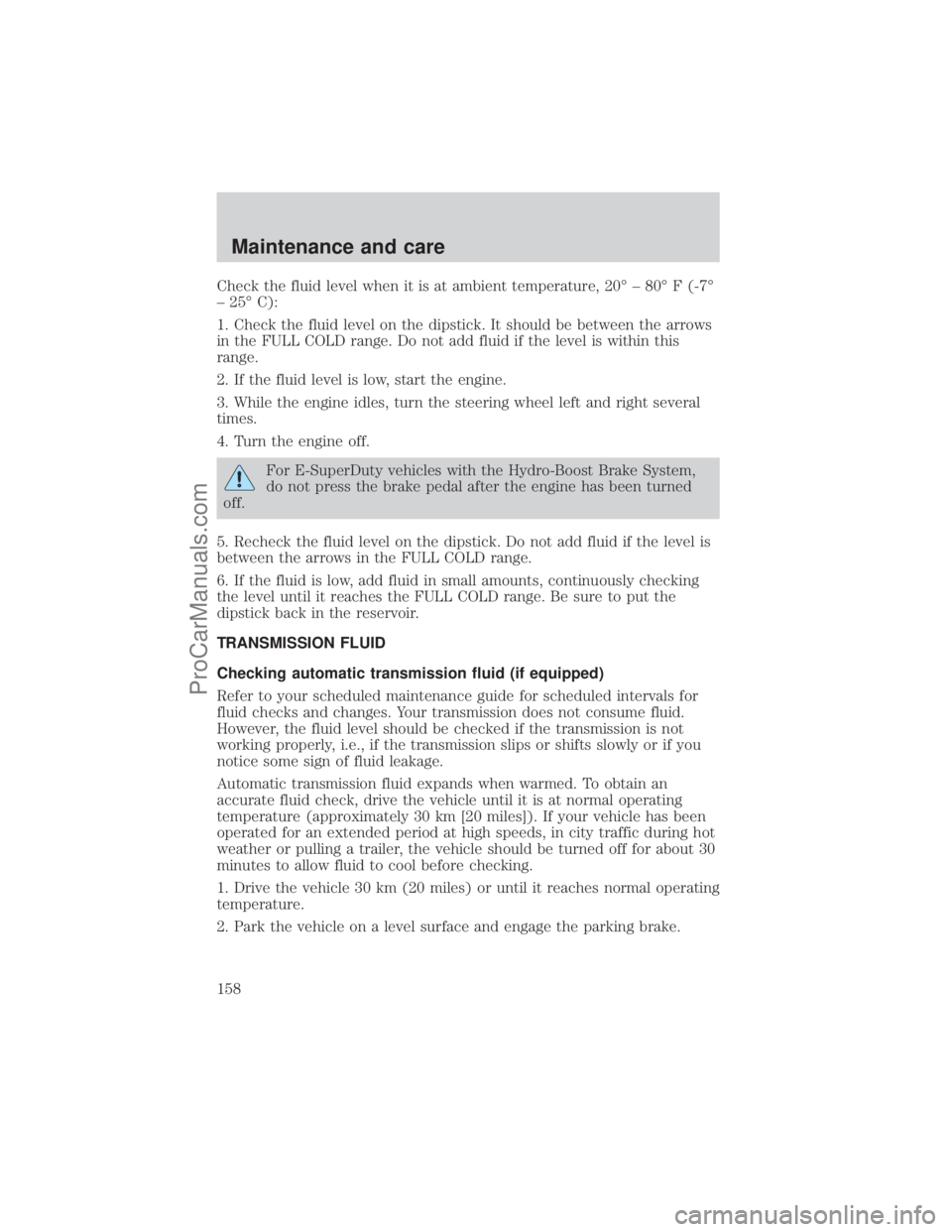
Check the fluid level when it is at ambient temperature, 20É ± 80É F (-7É
± 25É C):
1. Check the fluid level on the dipstick. It should be between the arrows
in the FULL COLD range. Do not add fluid if the level is within this
range.
2. If the fluid level is low, start the engine.
3. While the engine idles, turn the steering wheel left and right several
times.
4. Turn the engine off.
For E-SuperDuty vehicles with the Hydro-Boost Brake System,
do not press the brake pedal after the engine has been turned
off.
5. Recheck the fluid level on the dipstick. Do not add fluid if the level is
between the arrows in the FULL COLD range.
6. If the fluid is low, add fluid in small amounts, continuously checking
the level until it reaches the FULL COLD range. Be sure to put the
dipstick back in the reservoir.
TRANSMISSION FLUID
Checking automatic transmission fluid (if equipped)
Refer to your scheduled maintenance guide for scheduled intervals for
fluid checks and changes. Your transmission does not consume fluid.
However, the fluid level should be checked if the transmission is not
working properly, i.e., if the transmission slips or shifts slowly or if you
notice some sign of fluid leakage.
Automatic transmission fluid expands when warmed. To obtain an
accurate fluid check, drive the vehicle until it is at normal operating
temperature (approximately 30 km [20 miles]). If your vehicle has been
operated for an extended period at high speeds, in city traffic during hot
weather or pulling a trailer, the vehicle should be turned off for about 30
minutes to allow fluid to cool before checking.
1. Drive the vehicle 30 km (20 miles) or until it reaches normal operating
temperature.
2. Park the vehicle on a level surface and engage the parking brake.
Maintenance and care
158
ProCarManuals.com
Page 159 of 224
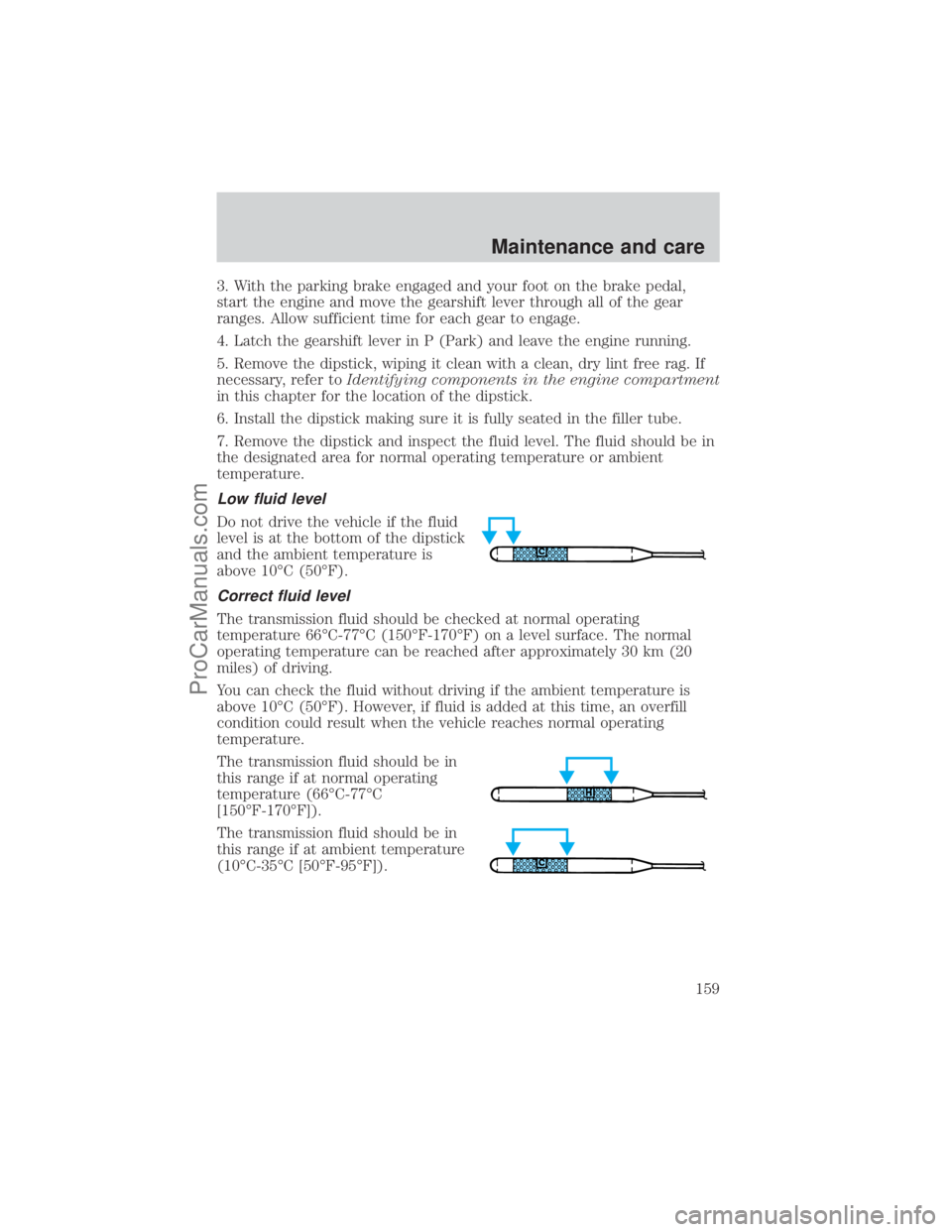
3. With the parking brake engaged and your foot on the brake pedal,
start the engine and move the gearshift lever through all of the gear
ranges. Allow sufficient time for each gear to engage.
4. Latch the gearshift lever in P (Park) and leave the engine running.
5. Remove the dipstick, wiping it clean with a clean, dry lint free rag. If
necessary, refer toIdentifying components in the engine compartment
in this chapter for the location of the dipstick.
6. Install the dipstick making sure it is fully seated in the filler tube.
7. Remove the dipstick and inspect the fluid level. The fluid should be in
the designated area for normal operating temperature or ambient
temperature.
Low fluid level
Do not drive the vehicle if the fluid
level is at the bottom of the dipstick
and the ambient temperature is
above 10ÉC (50ÉF).
Correct fluid level
The transmission fluid should be checked at normal operating
temperature 66ÉC-77ÉC (150ÉF-170ÉF) on a level surface. The normal
operating temperature can be reached after approximately 30 km (20
miles) of driving.
You can check the fluid without driving if the ambient temperature is
above 10ÉC (50ÉF). However, if fluid is added at this time, an overfill
condition could result when the vehicle reaches normal operating
temperature.
The transmission fluid should be in
this range if at normal operating
temperature (66ÉC-77ÉC
[150ÉF-170ÉF]).
The transmission fluid should be in
this range if at ambient temperature
(10ÉC-35ÉC [50ÉF-95ÉF]).
Maintenance and care
159
ProCarManuals.com
Page 188 of 224
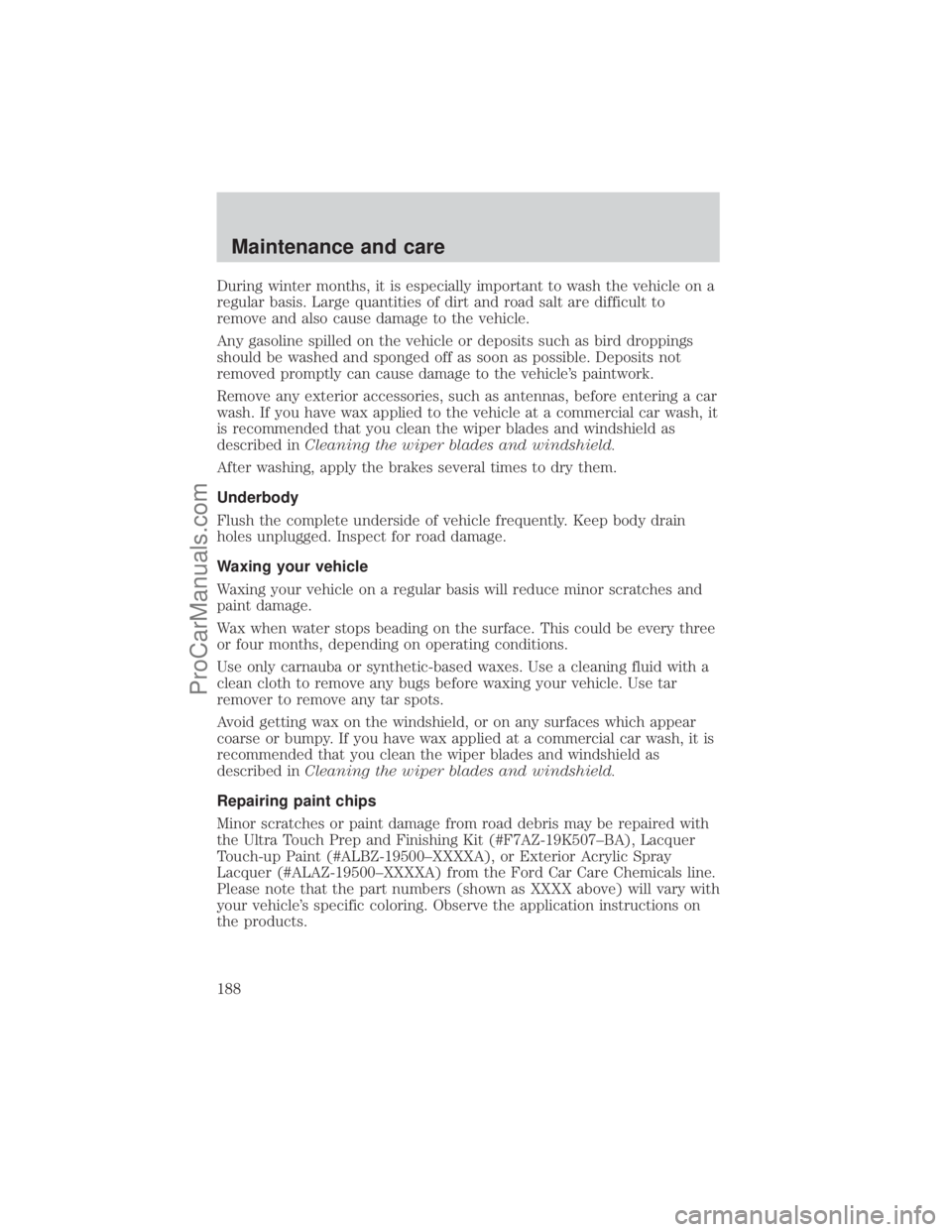
During winter months, it is especially important to wash the vehicle on a
regular basis. Large quantities of dirt and road salt are difficult to
remove and also cause damage to the vehicle.
Any gasoline spilled on the vehicle or deposits such as bird droppings
should be washed and sponged off as soon as possible. Deposits not
removed promptly can cause damage to the vehicle's paintwork.
Remove any exterior accessories, such as antennas, before entering a car
wash. If you have wax applied to the vehicle at a commercial car wash, it
is recommended that you clean the wiper blades and windshield as
described inCleaning the wiper blades and windshield.
After washing, apply the brakes several times to dry them.
Underbody
Flush the complete underside of vehicle frequently. Keep body drain
holes unplugged. Inspect for road damage.
Waxing your vehicle
Waxing your vehicle on a regular basis will reduce minor scratches and
paint damage.
Wax when water stops beading on the surface. This could be every three
or four months, depending on operating conditions.
Use only carnauba or synthetic-based waxes. Use a cleaning fluid with a
clean cloth to remove any bugs before waxing your vehicle. Use tar
remover to remove any tar spots.
Avoid getting wax on the windshield, or on any surfaces which appear
coarse or bumpy. If you have wax applied at a commercial car wash, it is
recommended that you clean the wiper blades and windshield as
described inCleaning the wiper blades and windshield.
Repairing paint chips
Minor scratches or paint damage from road debris may be repaired with
the Ultra Touch Prep and Finishing Kit (#F7AZ-19K507±BA), Lacquer
Touch-up Paint (#ALBZ-19500±XXXXA), or Exterior Acrylic Spray
Lacquer (#ALAZ-19500±XXXXA) from the Ford Car Care Chemicals line.
Please note that the part numbers (shown as XXXX above) will vary with
your vehicle's specific coloring. Observe the application instructions on
the products.
Maintenance and care
188
ProCarManuals.com
Page 193 of 224
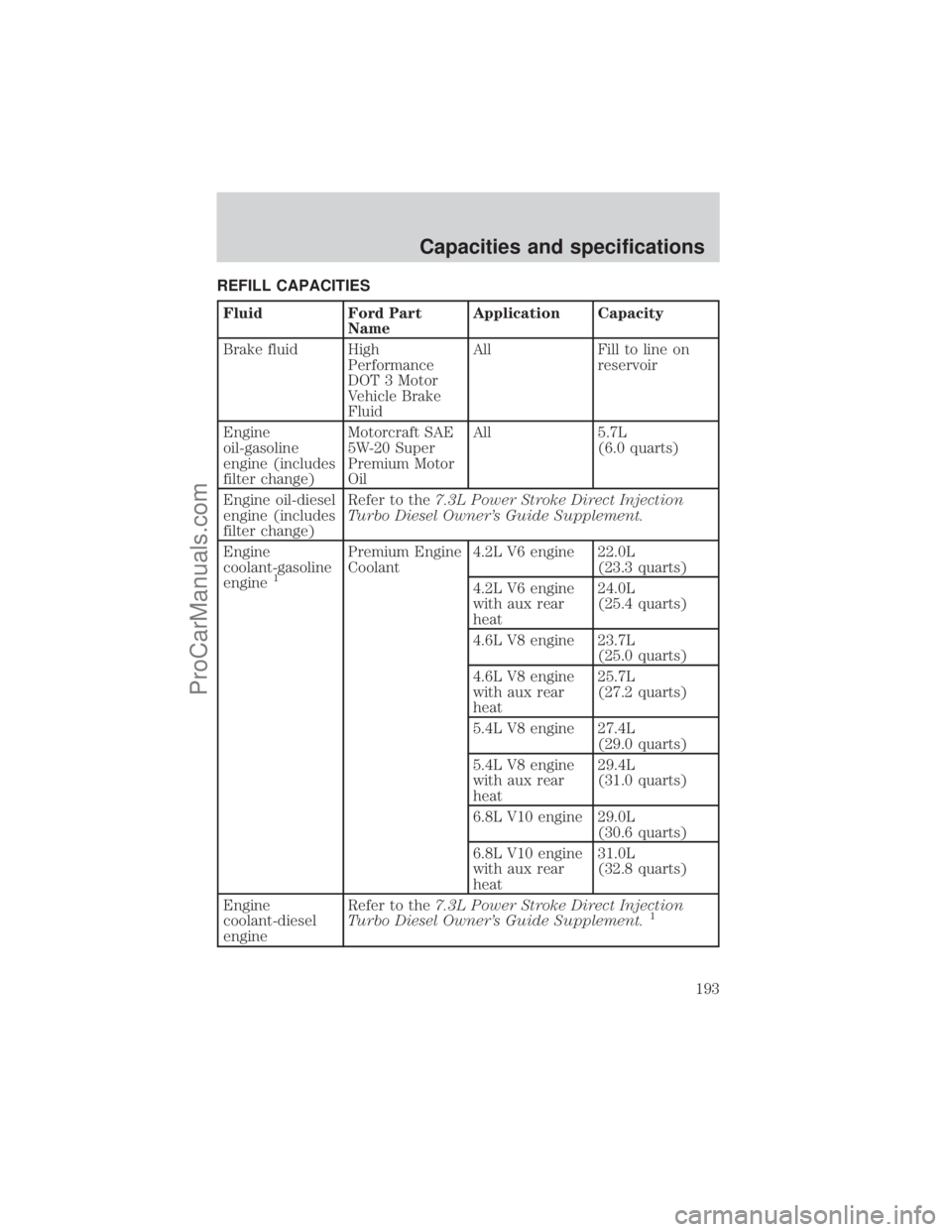
REFILL CAPACITIES
Fluid Ford Part
NameApplication Capacity
Brake fluid High
Performance
DOT 3 Motor
Vehicle Brake
FluidAll Fill to line on
reservoir
Engine
oil-gasoline
engine (includes
filter change)Motorcraft SAE
5W-20 Super
Premium Motor
OilAll 5.7L
(6.0 quarts)
Engine oil-diesel
engine (includes
filter change)Refer to the7.3L Power Stroke Direct Injection
Turbo Diesel Owner's Guide Supplement.
Engine
coolant-gasoline
engine
1
Premium Engine
Coolant4.2L V6 engine 22.0L
(23.3 quarts)
4.2L V6 engine
with aux rear
heat24.0L
(25.4 quarts)
4.6L V8 engine 23.7L
(25.0 quarts)
4.6L V8 engine
with aux rear
heat25.7L
(27.2 quarts)
5.4L V8 engine 27.4L
(29.0 quarts)
5.4L V8 engine
with aux rear
heat29.4L
(31.0 quarts)
6.8L V10 engine 29.0L
(30.6 quarts)
6.8L V10 engine
with aux rear
heat31.0L
(32.8 quarts)
Engine
coolant-diesel
engineRefer to the7.3L Power Stroke Direct Injection
Turbo Diesel Owner's Guide Supplement.
1
Capacities and specifications
193
ProCarManuals.com
Page 196 of 224
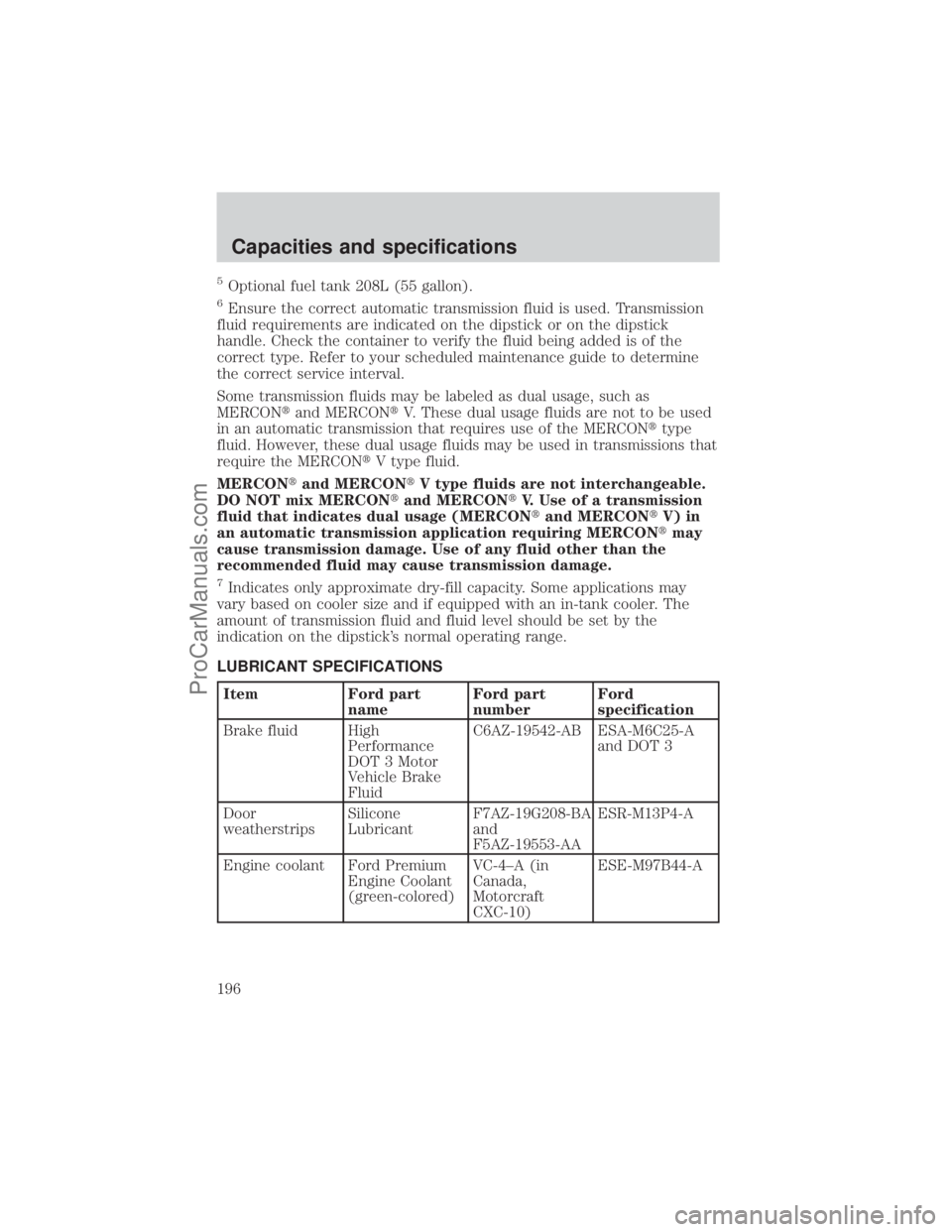
5Optional fuel tank 208L (55 gallon).
6Ensure the correct automatic transmission fluid is used. Transmission
fluid requirements are indicated on the dipstick or on the dipstick
handle. Check the container to verify the fluid being added is of the
correct type. Refer to your scheduled maintenance guide to determine
the correct service interval.
Some transmission fluids may be labeled as dual usage, such as
MERCONtand MERCONtV. These dual usage fluids are not to be used
in an automatic transmission that requires use of the MERCONttype
fluid. However, these dual usage fluids may be used in transmissions that
require the MERCONtV type fluid.
MERCONtand MERCONtV type fluids are not interchangeable.
DO NOT mix MERCONtand MERCONtV. Use of a transmission
fluid that indicates dual usage (MERCONtand MERCONtV) in
an automatic transmission application requiring MERCONtmay
cause transmission damage. Use of any fluid other than the
recommended fluid may cause transmission damage.
7Indicates only approximate dry-fill capacity. Some applications may
vary based on cooler size and if equipped with an in-tank cooler. The
amount of transmission fluid and fluid level should be set by the
indication on the dipstick's normal operating range.
LUBRICANT SPECIFICATIONS
Item Ford part
nameFord part
numberFord
specification
Brake fluid High
Performance
DOT 3 Motor
Vehicle Brake
FluidC6AZ-19542-AB ESA-M6C25-A
and DOT 3
Door
weatherstripsSilicone
LubricantF7AZ-19G208-BA
and
F5AZ-19553-AAESR-M13P4-A
Engine coolant Ford Premium
Engine Coolant
(green-colored)VC-4±A (in
Canada,
Motorcraft
CXC-10)ESE-M97B44-A
Capacities and specifications
196
ProCarManuals.com
Page 197 of 224
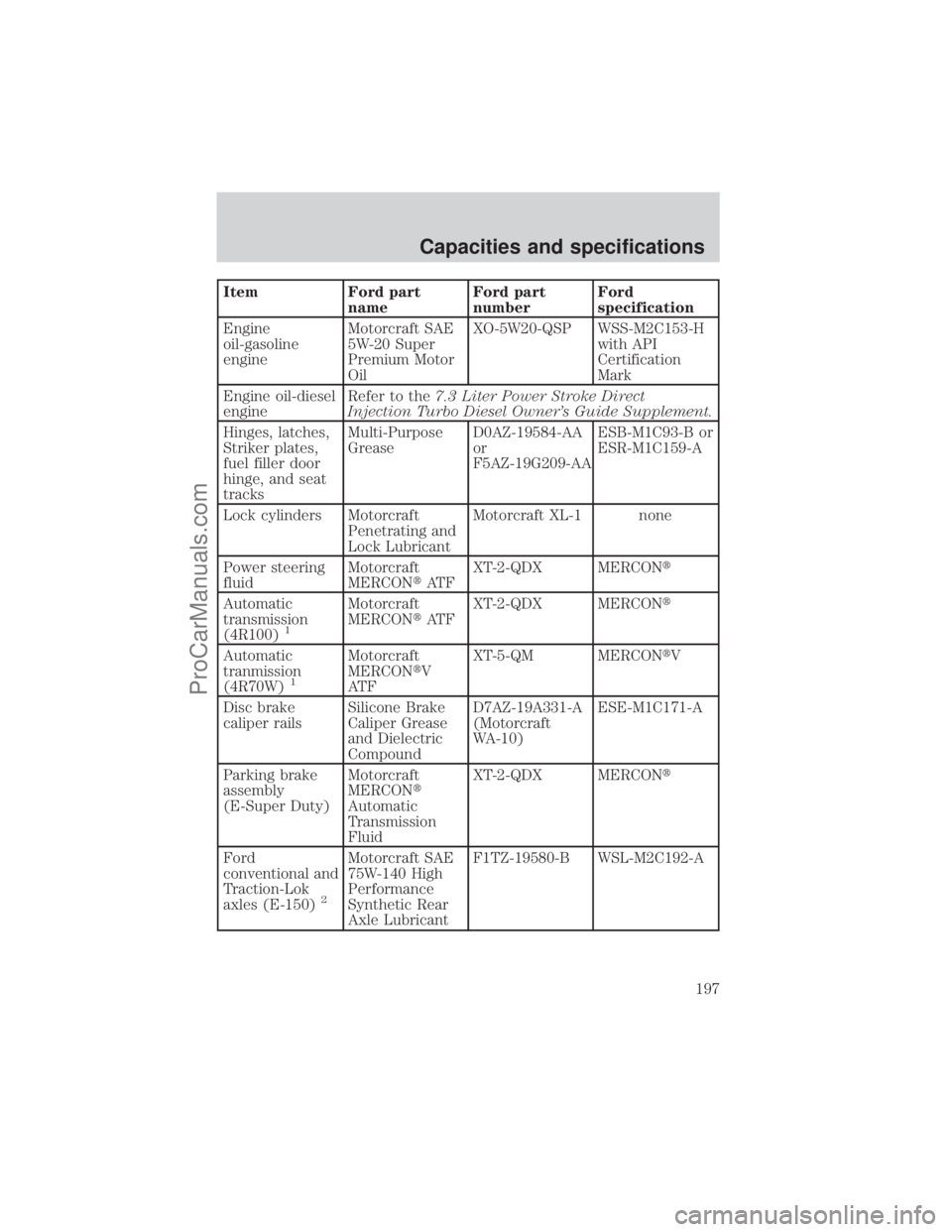
Item Ford part
nameFord part
numberFord
specification
Engine
oil-gasoline
engineMotorcraft SAE
5W-20 Super
Premium Motor
OilXO-5W20-QSP WSS-M2C153-H
with API
Certification
Mark
Engine oil-diesel
engineRefer to the7.3 Liter Power Stroke Direct
Injection Turbo Diesel Owner's Guide Supplement.
Hinges, latches,
Striker plates,
fuel filler door
hinge, and seat
tracksMulti-Purpose
GreaseD0AZ-19584-AA
or
F5AZ-19G209-AAESB-M1C93-B or
ESR-M1C159-A
Lock cylinders Motorcraft
Penetrating and
Lock LubricantMotorcraft XL-1 none
Power steering
fluidMotorcraft
MERCONtAT FXT-2-QDX MERCONt
Automatic
transmission
(4R100)
1
Motorcraft
MERCONtAT FXT-2-QDX MERCONt
Automatic
tranmission
(4R70W)
1
Motorcraft
MERCONtV
AT FXT-5-QM MERCONtV
Disc brake
caliper railsSilicone Brake
Caliper Grease
and Dielectric
CompoundD7AZ-19A331-A
(Motorcraft
WA-10)ESE-M1C171-A
Parking brake
assembly
(E-Super Duty)Motorcraft
MERCONt
Automatic
Transmission
FluidXT-2-QDX MERCONt
Ford
conventional and
Traction-Lok
axles (E-150)
2
Motorcraft SAE
75W-140 High
Performance
Synthetic Rear
Axle LubricantF1TZ-19580-B WSL-M2C192-A
Capacities and specifications
197
ProCarManuals.com
Page 216 of 224
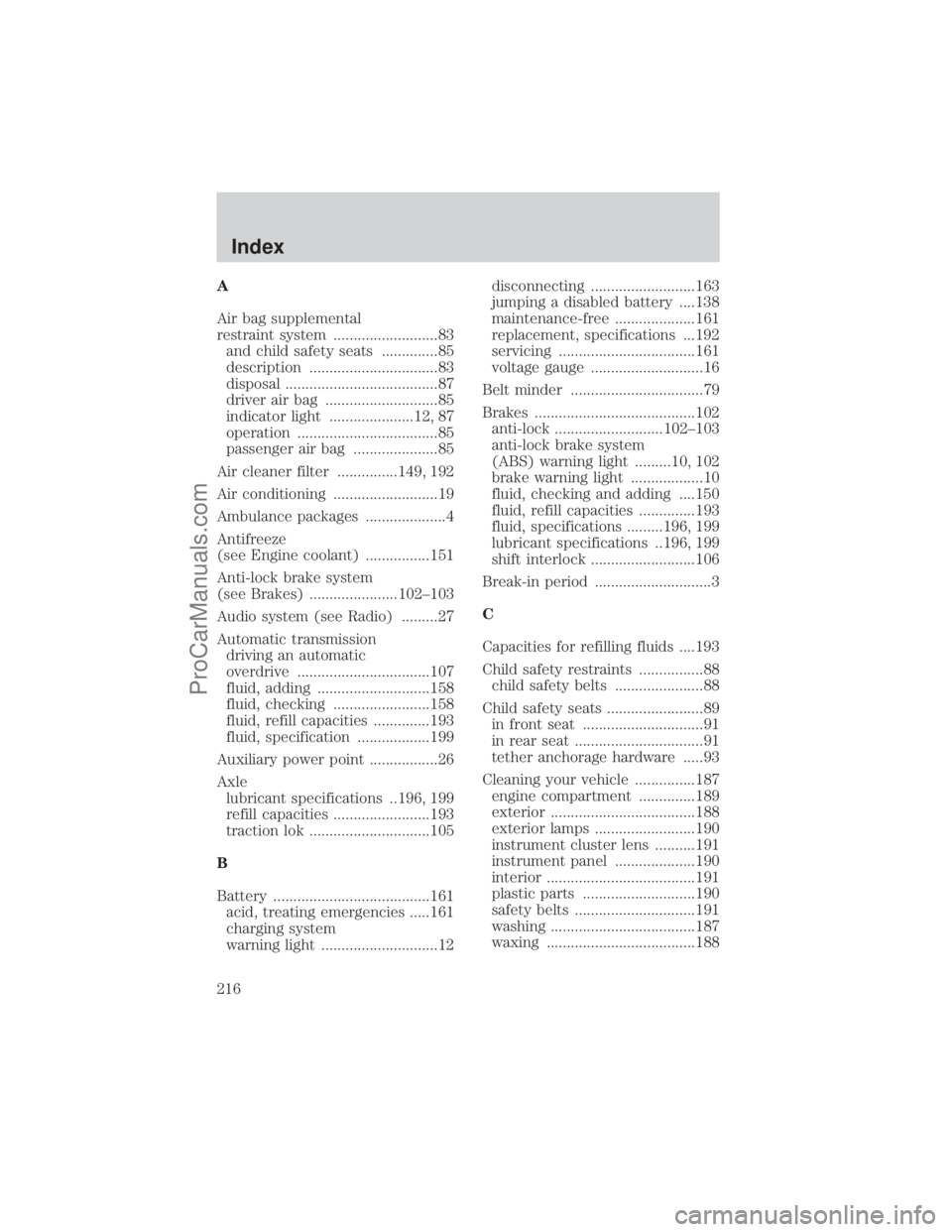
A
Air bag supplemental
restraint system ..........................83
and child safety seats ..............85
description ................................83
disposal ......................................87
driver air bag ............................85
indicator light .....................12, 87
operation ...................................85
passenger air bag .....................85
Air cleaner filter ...............149, 192
Air conditioning ..........................19
Ambulance packages ....................4
Antifreeze
(see Engine coolant) ................151
Anti-lock brake system
(see Brakes) ......................102±103
Audio system (see Radio) .........27
Automatic transmission
driving an automatic
overdrive .................................107
fluid, adding ............................158
fluid, checking ........................158
fluid, refill capacities ..............193
fluid, specification ..................199
Auxiliary power point .................26
Axle
lubricant specifications ..196, 199
refill capacities ........................193
traction lok ..............................105
B
Battery .......................................161
acid, treating emergencies .....161
charging system
warning light .............................12disconnecting ..........................163
jumping a disabled battery ....138
maintenance-free ....................161
replacement, specifications ...192
servicing ..................................161
voltage gauge ............................16
Belt minder .................................79
Brakes ........................................102
anti-lock ...........................102±103
anti-lock brake system
(ABS) warning light .........10, 102
brake warning light ..................10
fluid, checking and adding ....150
fluid, refill capacities ..............193
fluid, specifications .........196, 199
lubricant specifications ..196, 199
shift interlock ..........................106
Break-in period .............................3
C
Capacities for refilling fluids ....193
Child safety restraints ................88
child safety belts ......................88
Child safety seats ........................89
in front seat ..............................91
in rear seat ................................91
tether anchorage hardware .....93
Cleaning your vehicle ...............187
engine compartment ..............189
exterior ....................................188
exterior lamps .........................190
instrument cluster lens ..........191
instrument panel ....................190
interior .....................................191
plastic parts ............................190
safety belts ..............................191
washing ....................................187
waxing .....................................188
Index
216
ProCarManuals.com
Page 220 of 224

P
Panic alarm feature, remote
entry system ................................63
Parking brake ............................103
Parts (see Motorcraft parts) ....192
Power distribution box
(see Fuses) ...............................128
Power door locks ........................61
Power steering ..........................104
fluid, checking and adding ....157
fluid, refill capacity ................193
fluid, specifications .........196, 199
Preparing to
drive your vehicle .....................105
R
Radio ............................................27
Relays ................................124, 131
Remote entry system ...........62±63
illuminated entry ......................65
locking/unlocking doors ...........63
panic alarm ...............................63
replacement/additional
transmitters ...............................65
replacing the batteries .............64
S
Safety belts (see
Safety restraints) ............14, 73±77
Safety defects, reporting ..........215
Safety restraints ....................73±77
belt minder ...............................79
cleaning the safety belts ..82, 191
extension assembly ..................78
for adults .............................74±76for children .........................87±88
lap belt ......................................78
warning light
and chime ......................12±13, 79
Safety seats for children ............89
Seat belts
(see Safety restraints) ...............73
Seats ............................................66
child safety seats ......................89
Servicing your vehicle ..............144
Spark plugs,
specifications .....................192, 199
Special notice ................................4
ambulance conversions ..............4
diesel-powered vehicles .............5
utility-type vehicles ....................4
Specification chart,
lubricants ...........................196, 199
Speed control ..............................50
Speedometer ...............................14
Starting your vehicle ..........98, 100
jump starting ..........................138
Steering wheel
tilting .........................................54
T
Tires ...........................131, 167±169
changing ..........................131, 133
checking the pressure ............169
replacing ..........................134, 170
rotating ....................................169
snow tires and chains ............171
tire grades ...............................168
treadwear ................................168
Towing .......................................112
recreational towing .................119
Index
220
ProCarManuals.com